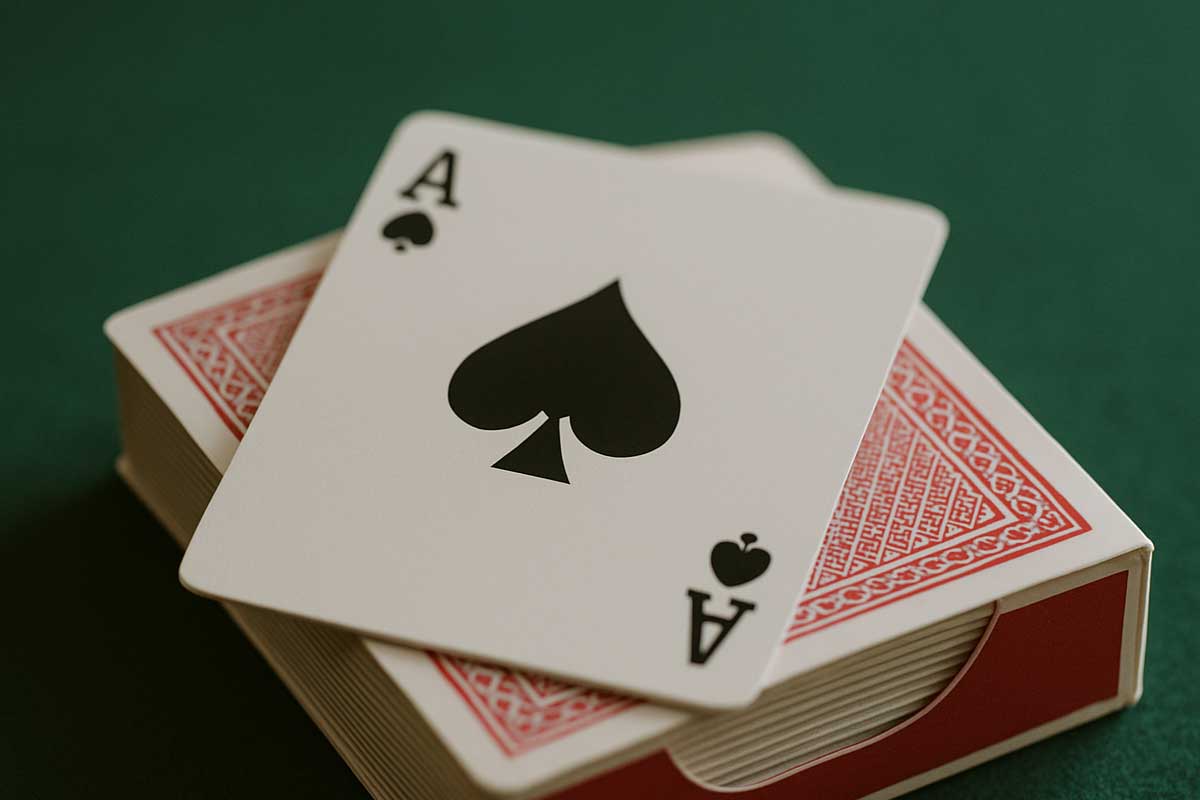This page may contain affiliate links. If you click and buy, we might get a small commission at no cost to you.
There are countless games to play with a deck of cards, making it one of the most versatile forms of entertainment around. Whether you’re hosting game night with friends, spending time with family, or trying to entertain a group of kids, classic card games are always a hit. Best of all, you don’t need anything extra, just a regular 52-card deck.
In this guide, we’ve broken things down into three categories: games for adults, games for families, and games for kids. Each one is easy to learn and fun to play, with clear rules and a suggested number of players.
Games for adults
1. Poker
Players: 2 or more (best with 4–6)
Poker is a classic betting game where players build hands and compete for chips or points. The most common version, Texas Hold’em, gives each player two private cards and five shared cards in the center. Players bet in rounds, trying to form the best five-card hand using any combination of their own cards and the shared ones.
In Five Card Draw, each player is dealt five cards and has one chance to discard and replace cards before a final betting round. You don’t need real betting to enjoy Poker—just keep score or play for fun prizes.
2. Spades
Players: 4 (in teams of 2)
Spades is a trick-taking game where players bid on how many tricks (or hands) they think they’ll win. Spades are always the trump suit, meaning they beat all other suits. Each player is dealt 13 cards, and teammates work together to fulfill their combined bid.
The game requires strategy, memory, and communication. Spades is easy to learn but has plenty of depth, which makes it great for regular game nights.
3. Hearts
Players: 3–6 (best with 4)
Hearts is another trick-taking game, but instead of trying to win tricks, you’re often trying to avoid them. Players want to steer clear of hearts and the queen of spades, which all carry penalty points. The goal is to have the lowest score by the end of the game.
Each round, players pass cards to one another before playing. This adds a layer of planning and sabotage that makes the game both clever and competitive.
4. Bridge
Players: 4 (in teams of 2)
Bridge is a highly strategic partnership game with complex rules and deep gameplay. Players bid to declare how many tricks their team will take, then try to achieve that contract using carefully coordinated play.
It takes time to learn, but many players find Bridge to be the most rewarding and intellectually challenging card game available.
5. Euchre
Players: 4 (in teams of 2)
Euchre uses a stripped-down 24-card deck (you can remove everything 2–8) and plays quickly with lots of action. One suit becomes the trump, and players try to win at least three of the five tricks each round.
It’s especially popular in the Midwest and is known for its fast pace and strong social element.
6. Pinochle
Players: 4 (in teams of 2)
Pinochle is traditionally played with a 48-card deck made by doubling 9s through Aces. You can create this with two standard decks. Players bid, name a trump suit, and aim to score points through combinations of cards and by taking tricks.
It’s complex but rewarding, and has a loyal following among dedicated card players.
Games for families
7. Rummy
Players: 2–6
Rummy is a matching game where players aim to form sets (three or four of the same rank) or runs (three or more consecutive cards of the same suit). Each player is dealt a hand and draws or discards cards in turn, trying to be the first to go out.
The basic version is simple enough for kids to pick up, but still strategic enough to keep adults engaged.
8. Gin Rummy
Players: 2
Gin Rummy is a streamlined two-player version of Rummy. Players try to form sets and runs, and then “knock” to end the round when their deadwood (non-matching cards) total 10 or fewer points.
Scoring adds a bit of complexity, but it’s a fast and addictive game perfect for quiet evenings or travel.
9. Crazy Eights
Players: 2–6
Crazy Eights is the ancestor of Uno and plays very similarly. Each player is dealt five or more cards. On your turn, you discard a card that matches either the suit or the rank of the top card on the pile. Eights are wild and can be played at any time, changing the suit.
The first player to get rid of all their cards wins the round. It’s colorful, unpredictable, and a great game for all ages.
10. Kings in the Corner
Players: 2–4
Kings in the Corner is a layout-based game where players build down in alternating colors, much like solitaire. The goal is to get rid of all your cards by building sequences on shared piles, and Kings can start new piles in the corners.
It’s a great mix of strategy and luck, and works well with families or casual players.
11. Uno (using a standard deck)
Players: 2–6
You can replicate Uno using a regular deck of cards. Assign each suit a color (e.g., hearts = red, spades = blue), and use specific cards as action cards:
– 2 = Draw Two
– 8 = Skip
– 10 = Reverse
– Joker or unused card = Wild
Play follows the same match-by-number-or-color pattern as Uno. Kids familiar with Uno can adapt to this version quickly.
12. Speed
Players: 2
Speed is a fast-paced game where both players try to get rid of their cards as quickly as possible. Each player has a small hand and two face-up piles in the center. Players simultaneously play cards that are one number above or below the top card on either center pile.
No turns, no waiting—just constant action. It’s a favorite among siblings and friends.
13. Slapjack
Players: 2 or more
In Slapjack, players take turns flipping cards into a central pile. When a Jack appears, everyone tries to be the first to slap it. The winner of the slap takes the pile.
It’s high-energy and hilarious, especially for younger players who love fast reactions and a bit of chaos.
Games for kids
14. Go Fish
Players: 2–6
Each player is dealt a hand of cards. On your turn, you ask another player if they have a certain rank (“Do you have any threes?”). If they do, they give you all cards of that rank. If not, you “go fish” by drawing from the deck.
The goal is to collect sets of four. It’s great for younger children just learning the ranks and suits.
15. Old Maid
Players: 2 or more
Remove one Queen from the deck, then deal out the cards. Players take turns drawing one card from the next person’s hand. If you get a pair, you lay it down. The player left with the unmatchable “Old Maid” card loses.
It’s simple, silly, and full of suspense—especially for kids.
16. War
Players: 2
War is a no-brainer game where each player flips a card at the same time. The higher card wins both cards. If there’s a tie, players go to “war” by placing three cards face-down and then another face-up—winner takes all.
There’s no skill involved, just luck and excitement. Kids love watching the pile grow and hoping for a comeback.
17. Memory (Concentration)
Players: 2 or more
Use half a deck and lay cards face down in a grid. Players take turns flipping two cards, trying to find matching pairs. If a match is found, the player keeps the pair and takes another turn. If not, the cards are flipped back.
This game sharpens memory and is great for all ages, especially when you need a quiet activity.
18. Egyptian Rat Screw
Players: 2 or more
This game mixes War and Slapjack. Players flip cards into a central pile, and certain patterns (like doubles or sandwiches) trigger a slap. The first to slap wins the pile. Face cards trigger mini challenges where the next player must lay down more cards to counter.
It’s fast, chaotic, and better for older kids or teens who can handle the quick pace.



